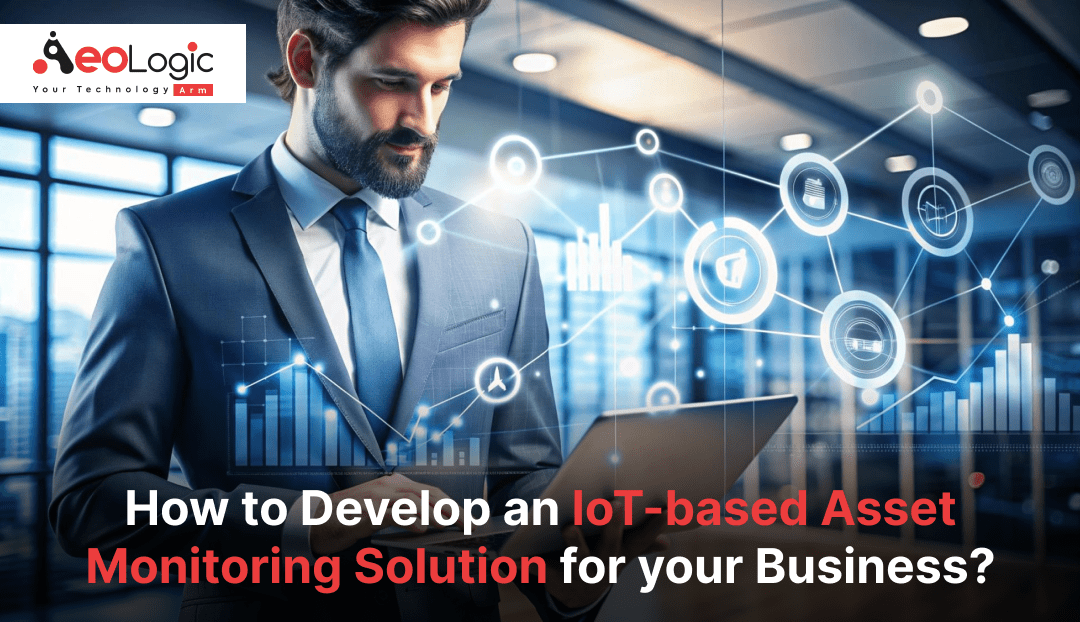In today’s rapidly evolving business environment, efficient asset management is crucial for maintaining operational effectiveness and minimizing costs. Asset tracking helps prevent theft, loss, and damage, while ensuring compliance with industry regulations and standards.
With the advent of Internet of Things (IoT) technology, asset management has become more precise and reliable. IoT-based asset monitoring solution offer real-time data and insights, transforming how businesses monitor and optimize their assets. This guide will walk you through the essential steps to develop an IoT-based asset monitoring solution for your business.
Also read: Boost Efficiency & Visibility With IoT Asset Tracking Solutions
Understanding IoT-Based Asset Monitoring Solution
IoT-based Asset monitoring involve overseeing an organization’s assets throughout their lifecycle. This can include physical assets like machinery, equipment, and vehicles, as well as digital assets such as software licenses and domain names. Effective asset management aims to maximize asset utilization, minimize downtime, control costs, and ensure compliance with regulations. It also involves strategies to extend an asset’s lifespan and increase its value to the company.
Key Steps to Developing an IoT-Based Asset Monitoring Solution
Define Your Objectives
The first step in developing an IoT-based asset monitoring solution is to clearly define your goals. Understanding what you want to achieve will guide all subsequent decisions and efforts. Common objectives for IoT asset monitoring include:
Identify Key Assets
Once your objectives are defined, the next step is to identify the assets you want to monitor. Assets can be physical, like machinery and vehicles, or digital, such as servers and software. Categorize these assets based on their importance, monitoring requirements, and impact on your business operations:
Choose the Right IoT Sensors and Devices
Selecting appropriate sensors and devices is crucial for effective asset monitoring. Different IoT sensors serve various purposes:
– GPS Trackers: Ideal for tracking the location of mobile assets like vehicles.
– Temperature Sensors: Monitor environmental conditions for sensitive items such as pharmaceuticals or perishable goods.
– Vibration Sensors: Detect mechanical issues or anomalies in equipment.
– RFID Tags: RFID solutions are suitable for tracking inventory and asset movement within a facility.
Ensure the sensors you choose are compatible with your assets and capable of providing accurate, relevant data. Consider factors such as sensor accuracy, battery life, and ease of installation.
Develop or Choose a Platform
Decide whether to develop a custom solution or use an existing IoT platform. Each option has its advantages:
– Custom Development: Offers tailored features and flexibility but requires significant time and resources. This is suitable if you have unique needs that off-the-shelf solutions cannot meet.
– Existing Platforms: Many IoT platforms provide comprehensive solutions with features like data visualization, analytics, and integration capabilities. These platforms are often quicker to deploy and easier to maintain.
Evaluate platforms based on their functionality, scalability, integration capabilities, and cost. Ensure they align with your objectives and existing systems.
Ensure Reliable Connectivity
Reliable connectivity is essential for the effectiveness of an IoT system. Choose the appropriate connectivity technology based on your assets’ location, data transmission needs, and power requirements:
Select a connectivity solution that provides reliable communication and meets your operational needs.
Integrate with Existing Systems
To maximize the benefits of your IoT-based asset monitoring solution, integrate it with your existing systems:
– Enterprise Resource Planning (ERP): Connect IoT data with ERP systems for improved asset management, financial tracking, and operational planning.
– Customer Relationship Management (CRM): Integrate with CRM systems to better manage customer interactions and service delivery based on asset performance data.
– Maintenance Management Systems: Link with maintenance systems to automate work orders, track maintenance activities, and predict future maintenance needs.
Integration ensures seamless data flow across systems, offering a comprehensive view of asset performance and facilitating better decision-making.
Develop a Data Management Strategy
IoT devices generate large amounts of data, making a robust data management strategy crucial.
A well-defined data management strategy will help you leverage the full potential of the data collected by your IoT solution.
Implement and Test
Once you’ve developed your IoT-based asset monitoring solution and integrated it with existing systems, it’s time to implement and test the system. Start with a pilot phase to:
– Identify Issues: Detect and address any technical or operational issues before full-scale deployment.
– Gather Feedback: Obtain feedback from users to understand their experience and make necessary adjustments.
– Refine the System: Make improvements based on pilot results to ensure the system meets all requirements and performs optimally.
Testing is a critical phase to ensure that the IoT solution functions as intended and integrates smoothly with your business processes.
Monitor and Optimize
The final step involves ongoing monitoring and optimization of your IoT-based asset monitoring solution. Regularly:
-Monitor Performance: Track system performance to identify and address areas for improvement.
-Collect Feedback: Continuously gather user feedback to understand their needs and address any issues.
-Update Technology: Stay informed about technological advancements to ensure your system remains effective and competitive.
Optimization ensures that your IoT solution continues to meet your needs and supports your business goals effectively.
Also read: The Importance of Remote Asset Management With IoT
Conclusion
Developing an IoT-based asset monitoring solution can significantly enhance your business operations by providing real-time insights, predictive maintenance capabilities, and improved efficiency. By following these steps—defining objectives, identifying key assets, selecting sensors, choosing a platform, ensuring connectivity, integrating systems, managing data, testing, training your team, and optimizing—you can create a robust and effective IoT solution tailored to your business needs.
Embrace the power of IoT to revolutionize asset management and drive your business forward. If you have any questions or need additional support, feel free to reach out.







